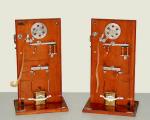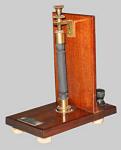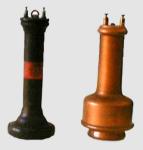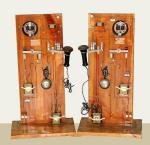

 Menu
Menu
|
School Spano |

|
||
|
Function To show how the transmission and reception of the telegraphic signals happen. | |||
|
|||
|
Description The two stations are placed symmetrically on two bases with foot, and include: a dry cell, a key, a schematic Morse receiver apparatus. All the connections are visible. | |||
|
School Spano |

|
||
|
Function To show the functioning of a carbon microphone. |
|||
|
|||
|
Description It is the classic model with only one carbon spindle. The mobile vertical carbon is held between two cylinders, one of them is fixed to the basis and the other is held by the fir-wood table, and its height can be regulated with screws with a clasp button. The connections are all visible. The base stands on rubber feet. It can be connected in series to a receiver and to a cell. The mobility of the carbon spindle must always be regulated by moving the upper screw that is fixed with the clasp button after reaching the greatest efficiency. | |||
|
School Castelvė |

|
||
|
Function To show the functioning of a carbon microphone. |
|||
|
|||
|
Fonction Model with only one carbon spindle. The mobile horizontal carbon is held by two blocks fixed on a fir-wooden basis. | |||
|
School Spano |

|
||
|
Function To show the functioning of a carbon microphone. |
|||
|
|||
|
Description The metallic basis is fixed to a wooden case on which a dial lamp is placed to indicate the microphone state. From the basis rises a metallic bar on which a circle is welded. The microphone is held by four springs in the centre of the circle to avoid the noises due to spurious oscillations. | |||
|
School Castelvė |

|
||
|
Function | |||
|
|||
|
School Spano |

|
||
|
Function It is a true demountable bipolar telephone. | |||
|
|||
|
Description The case and the ebonite handset are used only as a protection, because the magnet with the two coils wound on the iron core are joined to a brass funnel, on the edge of which lies the vibrating iron diaphragm. When reassembled, the telephone functions as before. | |||
|
School Spano |

|
||
|
Function To receive radiotelephonic calls. | |||
|
|||
|
Description The headphones have a great resistance, to use with slide-wire bridges and for telephony. It has special lamellar magnets. One of the pole is in the centre of the telephonic case; the other, in double, magnetizes an iron ring, on which lies a vibrant sheet. | |||
|
School Spano |

|
||
|
Function To show the functioning of the telephonic apparatus. | |||
|
|||
|
Description The microphone has three carbons, a bell supplied by a cell, a receiver, switches, a transformer and all the connections are placed on two symmetrical tables, that represent the complete telephonic places. The circuit of the bell inside the microphone and the external circuit of the receiver are made distinct by a different colouration. | |||